Planetary coolers, sometimes called satellite coolers can be grouped with the more general class of integral coolers, the common feature of which is that they are a rigidly-attached part of the structure of the rotary kiln, and rotate with it.
Up to 1920, the rotary coolers pioneered by Hurry and Seaman were standard on almost all rotary kiln installations, but they had a number of disadvantages that were by then well-known:
- Because the clinker (at 1200°C) must fall from the kiln outlet into the cooler, the kiln and its associated structures must be built high in the air, on massive and expensive piers.
- In order to recuperate the heat from the clinker and at the same time raise the temperature of the combustion air, the kiln must provide enough suction to draw air through the cooler, and this necessitates effective seals both between the kiln and the stationary kiln hood and between the kiln hood and the cooler. In the hot, abrasive conditions encountered, these moving seals are difficult to keep even approximately leak-proof.
- The cooler represents a separate item of plant, with its own drive and rollers requiring maintenance, but without which the kiln must stop, and so the potential for mechanical failure of the kiln system is increased.
The possibility of a cooler rigidly connected to the kiln evidently provides a possible solution to these problems.
In-line cooling zones
An early, mechanically inexpensive approach to tackling the problem was simply to extend the kiln tube and use this extension for cooling. This would, of course, involve extending the kiln firing pipe so that fuel was injected upstream of this cooling zone. This involved a more or less cumbersome cantilever arrangement to support the pipe. Some cooling arrangement was also needed, to prevent fuel from catching fire or coking before it reached the end of the pipe. Firing pipes even of ordinary length are subject to considerable danger of damage due to the intense radiant heat in the kiln and the tendency of chunks of loose coating to fall on them from above. Such extended pipes were therefore unreliable. The cooler could be simply a refractory-lined extension of the kiln, transferring heat inefficiently by radiation only, or lifters, as used in rotary coolers, could be used to improve heat exchange, but necessitating a complicated cantilevered hood to protect the firing pipe from the cascading clinker. A number of kilns were equipped with this kind of cooler:
| Masons A1 | 1913 | ||
| Rhoose A1 | 1913 | ||
| Rochester A2 | 1914 | ||
| Masons A2 | 1923 | ||
| Rhoose A2 | 1923 | ||
| Chinnor A1 | 1928 | ||
| ?South Ferriby A1 | 1938 |
The coolers in practice were almost useless. Masons, using them up to the 1960s, recorded clinker outlet temperature around 1000°C, and the “quenching” of the clinker, necessary for good quality, was delayed until it fell out onto the conveyor.
A modest improvement in performance could be obtained by fitting a “van der Werp” cooler. This involved perforating the shell of the kiln, and blowing air into the area where the clinker bed lay, from a sealed-on pressurized hood.
Early planetary coolers
The obvious demerits of the in-line cooler were tackled by allowing the clinker to run into tubes outside, and parallel with, the kiln tube. Two designs immediately emerged – the ordinary, downhill-flowing tubes, and the “reflex” tube, in which some sort of screw action caused the clinker to proceed uphill to the outlet.
Both designs do away with the leaky "kiln hood" used with other coolers. Instead, the front of the kiln is covered with a small "shield plate" pressed up against the kiln's front closure plate, allowing an effective and easily maintained seal with little inleak.
The advantage of the reflex design was a lower and more compact design, with straightforward access to the kiln for observation and maintenance. Disadvantages were the necessity of intact internals to maintain the uphill movement of clinker, particularly difficult in the refractory-lined zone. More important, there was the problem of supporting the outlet end at a point on the kiln shell where the temperature is high and variable.
The downhill discharging design avoided these problems, but had the major disadvantage that access to the front of the kiln could only be achieved by means of a cantilevered tubular steel tunnel. This feature was all the more inconvenient if it was necessary to withdraw hot air from the kiln for coal drying.
Both designs had major mechanical problems at the point where clinker entered the tubes. White hot clinker is falling in one direction, and high-temperature secondary air is flowing into the kiln, and it was difficult to keep the steel cool enough to maintain its strength, particularly with the smaller early kilns, where the small ducts had not much room for a thick layer of refractory to protect the steel. The connection was under continual flexural stress as the kiln turned, so tubes cracked, leaked hot clinker or fell off. Clinker dropping back out of the cooler over the firing pipe was a another nuisance. A further mechanical problem was in the design of the kiln. The cooler assembly was very heavy, the mass being supported largely by the kiln's front tyre, and unless many closely-spaced tyres were provided, the kiln was subject to large bending forces.
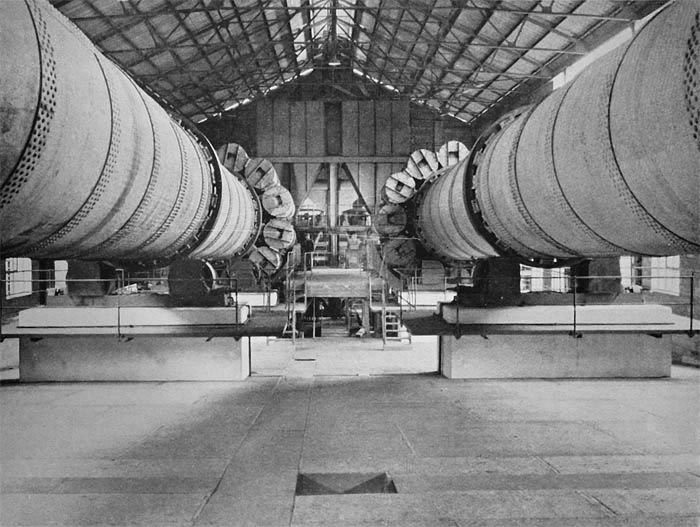 Early FLS "Unax" downhill discharging planetary cooler at Hope, 1929.
Early FLS "Unax" downhill discharging planetary cooler at Hope, 1929.
The seriousness of these problems diminished with the arrival of larger kilns and coolers, where more refractory insulation could be used, and more elaborate expansion joints could be accommodated. The relatively modern forms of the planetary cooler were all of the downhill-discharging design.
However, all planetary coolers have the problem that, in order to protect the kiln outlet ports, the flame must be projected well beyond them. This means that a length of the kiln - typically one to two diameters beyond the ports - is not available for sintering, and the kiln's "effective length" is diminished by this amount. Furthermore, rather sluggish cooling of the clinker occurs in this zone, to the detriment of clinker quality. From 1928 until WWII the majority of British kiln installations had "early" planetary coolers. Grate coolers started to be used from the late 1930s, and these became popular because of the known problems with planetary coolers and the rapid cooling effect of grates, and in a number of instances, kilns with planetary coolers were converted to grate cooling.
Modern planetary coolers
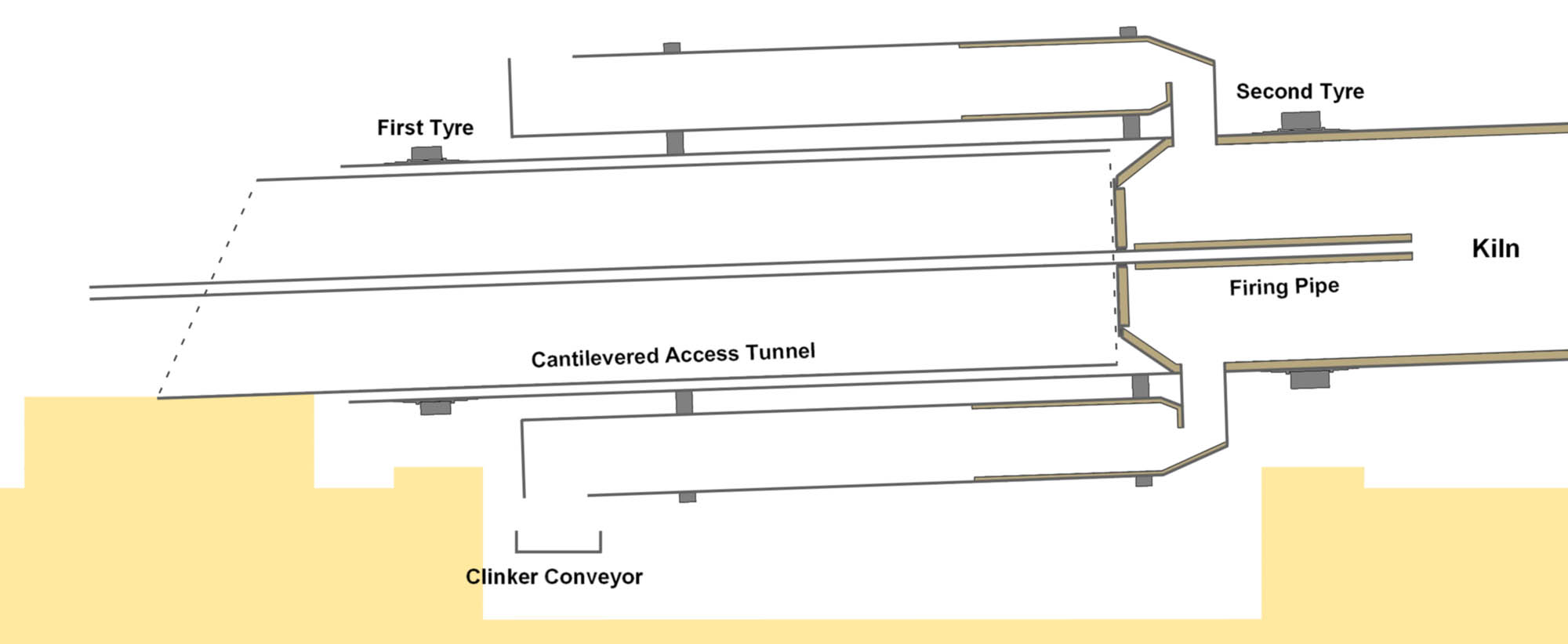 Later planetary cooler design
Later planetary cooler design
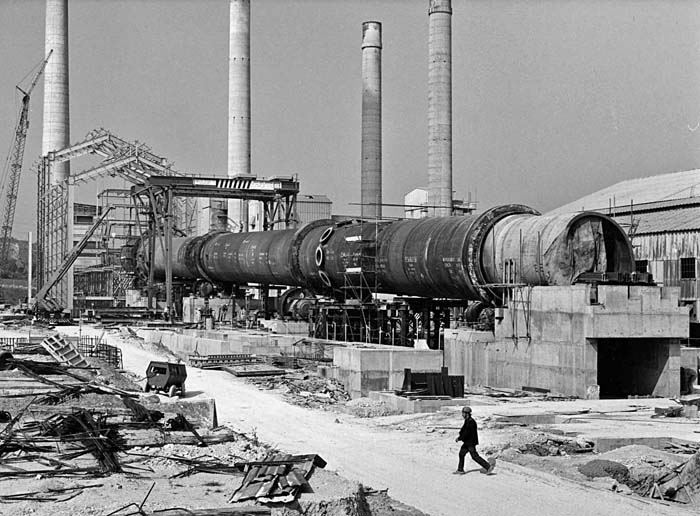 Picture: Rugby archive RC10. Rochester kiln 6 under construction, with the cooler tubes yet to be added, showing the substantial length of kiln shell used to support the cooler. The access tunnel, to the right, extends into the shell nearly as far as the cooler ports.
Picture: Rugby archive RC10. Rochester kiln 6 under construction, with the cooler tubes yet to be added, showing the substantial length of kiln shell used to support the cooler. The access tunnel, to the right, extends into the shell nearly as far as the cooler ports.
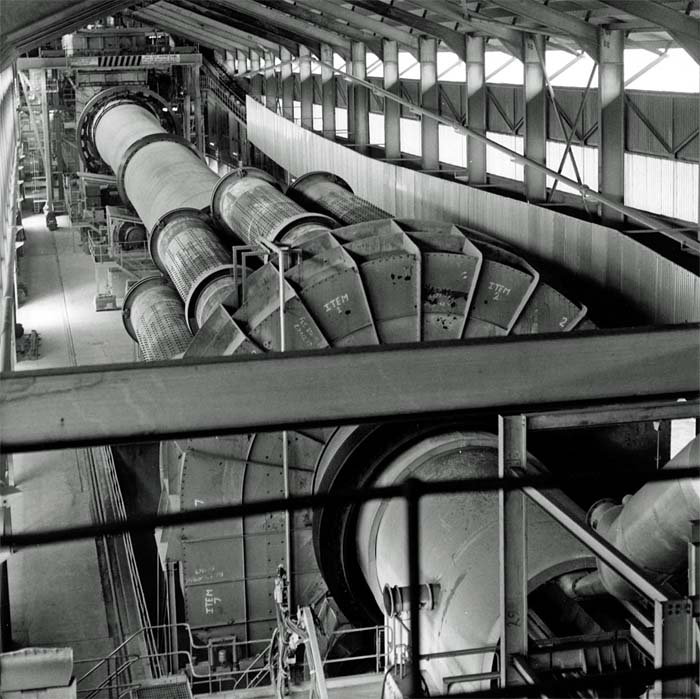 Picture: Rugby archive RC10. Rochester kiln 6 completed, showing the hood surrounding the clinker discharge and the end of the access tunnel in the foreground.
Picture: Rugby archive RC10. Rochester kiln 6 completed, showing the hood surrounding the clinker discharge and the end of the access tunnel in the foreground.
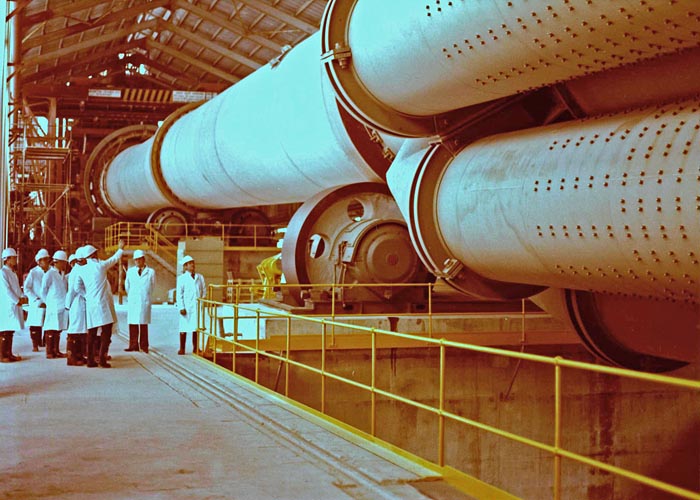 Picture: Rugby archive cat. no. RC10-5-1. Rochester kiln 6 showing the massive second pier rollers required for these coolers.
Picture: Rugby archive cat. no. RC10-5-1. Rochester kiln 6 showing the massive second pier rollers required for these coolers.
Difficulty in controlling the earlier grate coolers prompted a return to the use of planetary coolers on larger kilns in the post-war period. The problem of supporting the much larger cooling tubes was solved by extending the kiln tube and providing another tyre downhill from the cooler outlet, but at the expense of an extremely long access tunnel.
The new design began to be used in the late 1960s. Here is a complete list.
| Date | Kiln | Process | Supplier |
|---|---|---|---|
| 1967 | Ribblesdale 5 | Wet | FLS |
| 1968 | Rugby 6 | Wet | FLS |
| 1970 | Pitstone 5 | Long Dry | FLS |
| 1972 | Platin 1 | Long Dry | FLS |
| 1975 | Aberthaw 6 | SP | KHD |
| 1976 | Ribblesdale 6 | Wet | FLS |
| 1977 | Platin 2 | SP | FLS |
| 1977 | Ketton 7 | SP | FLS |
| 1978 | South Ferriby 3 | Lepol | FLS |
| 1980 | Rochester 6 | Lepol | FLS |
| 1983 | Limerick 6 | SP | FLS |
| 1989 | Derrylin 1 | SP | FCB |
Platin 2 and South Ferriby 3 were subsequently converted to grate coolers. The revival of planetary coolers in this form occurred because, despite the poor quenching and higher clinker temperatures produced, they were much simpler and cheaper than grate coolers, and could produce high secondary air temperatures. Because, unlike grate coolers, they produce no waste air, the heat loss from this is avoided, as is the need to clean the dusty exhaust air.
With the advent of precalciners, excess hot air from a grate cooler, previously wasted, could now be profitably used as tertiary air for the calciner, whereas the planetary cooler could produce no tertiary air. Because of this, planetary coolers became obsolete.
